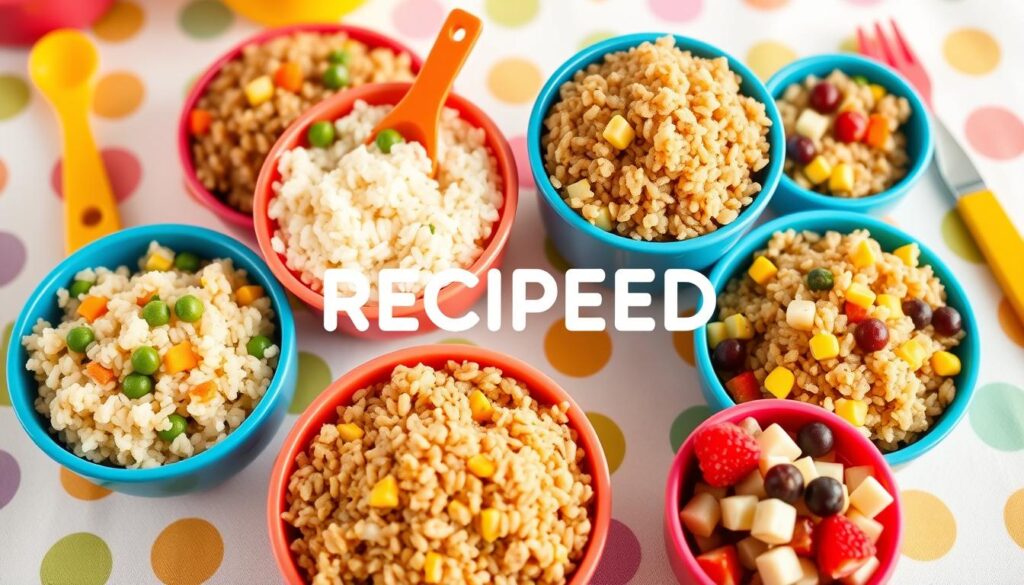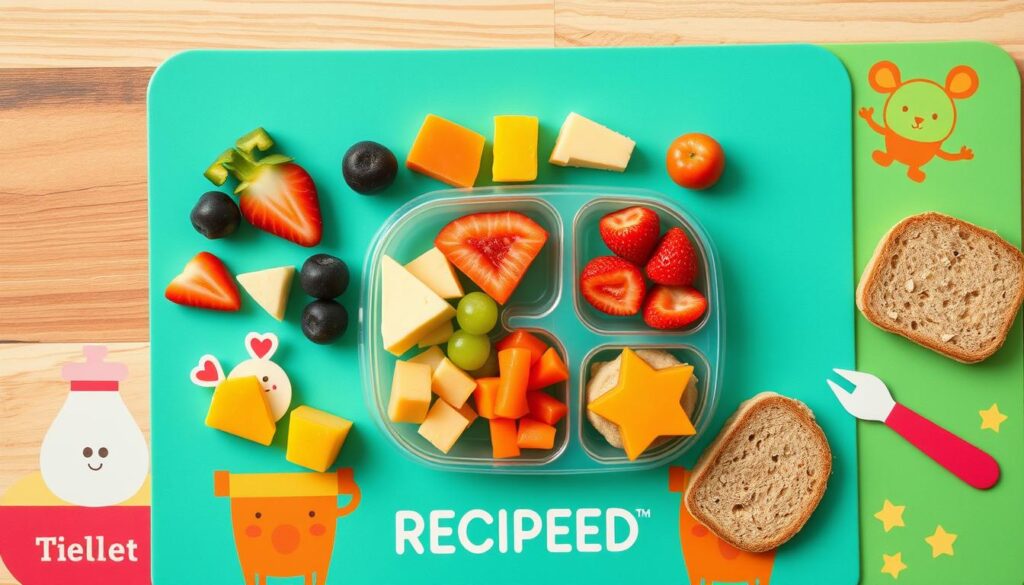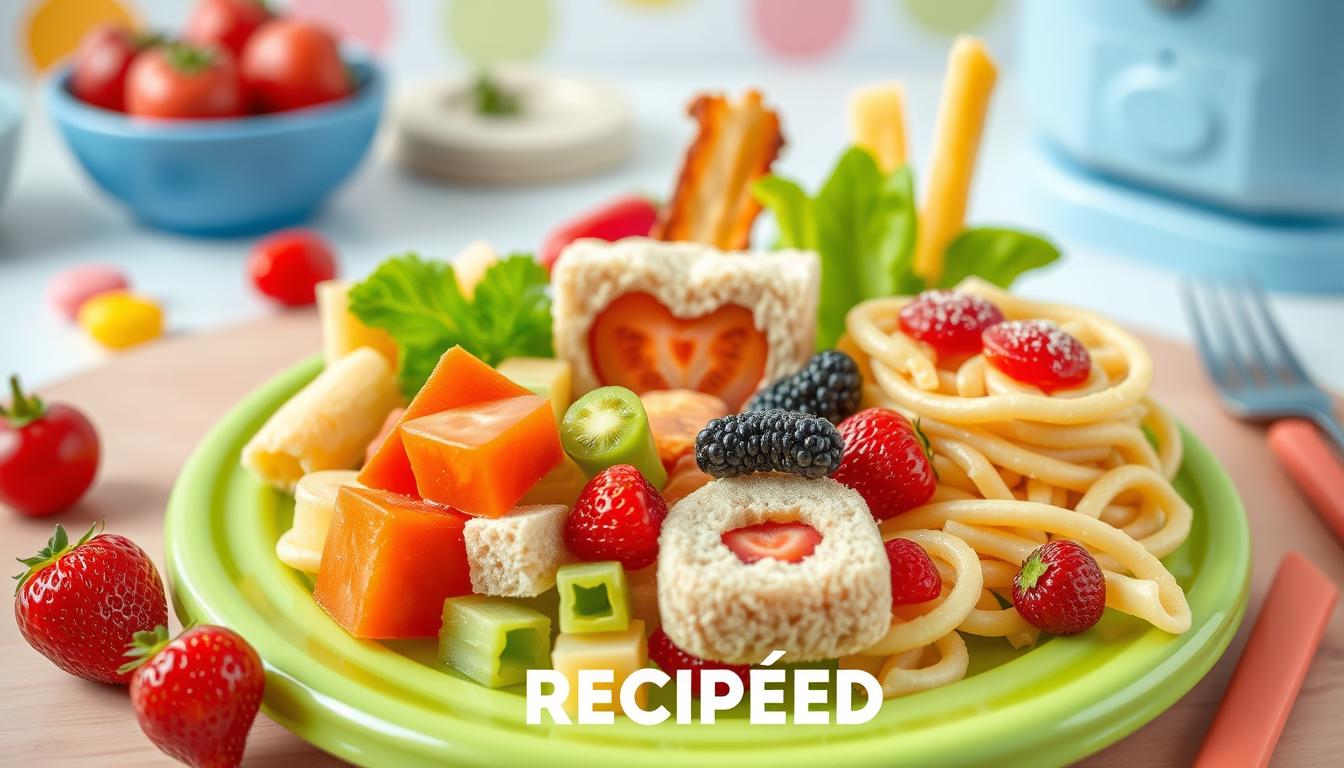Finding the right lunch ideas for a 1 year old can be tough. Parents want meals that are both healthy and tasty. Toddlers grow fast, and their eating habits change a lot, making it essential to find creative lunch ideas for 1-year-olds that they’ll enjoy
It’s important to have easy lunch recipes for kids. These meals keep them full and give them the nutrients they need. At this age, kids might start to picky eaters, so we need to get creative.
Knowing what your toddler needs helps make meals that are good for them. Serving small portions and finger foods is best. It lets kids try new things on their own.
We’ve picked lunch ideas that are full of variety and easy to make. Each recipe is made for 1-year-olds. They get the nutrients they need to grow strong.
Our lunch ideas make mealtime fun for everyone. By trying new foods and keeping things playful, we help kids develop good eating habits.
Table of Contents
Why Balanced Lunches Matter for Toddlers
Nutrition is key for your toddler’s growth and development. It’s not just about filling their belly. It’s about giving them the nutrients they need for their bodies and minds to grow.
Toddlers need lunch boxes that are full of the right nutrients. They need about 1,000 to 1,400 calories a day, depending on their size and activity level.
Importance of Nutrition in Early Development
Good nutrition in early years is vital for several reasons:
- It helps their brains grow and work well.
- It supports their physical growth and muscle strength.
- It boosts their immune system.
- It helps them develop good eating habits for life.
“Nutrition in early childhood is the foundation for future health and wellness.” – Pediatric Nutrition Expert
Encouraging Healthy Eating Habits
Starting good eating habits early is important. Here are some tips for healthy meals:
- Offer different textures and tastes.
- Let them try foods on their own.
- Be patient with new foods.
- Make mealtime fun.
Remember, kids might take up to 15 tries to like a new food. Keep trying and be creative to help them develop healthy eating habits.
Finger Foods Your 1-Year-Old Will Love
Introducing finger foods is a big step in your toddler’s eating journey. These small bites make mealtime fun and help with fine motor skills. Over 80% of these foods are plant-based, offering a healthy way to try new tastes and textures.
Finger foods are key for your child’s growth, turning meals into fun learning times. They help your child become independent and learn to feed themselves. This makes it easy to find kid-friendly lunch recipes that they’ll love.
Fun Shapes and Textures
Making finger foods look fun can get your child excited about eating. Try these creative ideas:
- Use cookie cutters to create fun shapes from fruits and vegetables
- Offer a variety of textures like soft, crunchy, and smooth foods
- Cut foods into small, bite-sized pieces
- Experiment with colorful produce to make meals exciting
“Variety is the spice of life, especially for growing toddlers!” – Pediatric Nutrition Experts
Easy-to-Pick-Up Options
When picking finger foods for babies, choose safe, nutritious options that are easy to hold. Here are some protein-rich and plant-based choices:
- Steamed vegetable pieces
- Soft fruit slices
- Small cheese cubes
- Well-cooked pasta shapes
- Soft-cooked legume pieces
Pro tip: Always watch your child during meals and cut foods into small, manageable pieces to prevent choking hazards.
Creative Sandwich Alternatives
Lunchtime for your 1-year-old doesn’t have to be dull! Try out easy kid-friendly lunch recipes to make meals fun. Nutritious lunch box ideas can offer more than just sandwiches. They can be exciting and keep your toddler happy and full.
Sandwiches can get old fast. That’s why it’s great to try new things. Your little one will enjoy these tasty and healthy lunch options.
Mini Wraps for Little Hands
Wraps are great for small hands and offer lots of tasty choices. Here are some yummy options:
- Hummus and vegetable mini wraps
- Soft whole grain tortilla rolls
- Avocado and turkey small rolls
- Cream cheese and cucumber pinwheels
Dips to Enhance Flavor
Dips can make simple foods exciting. Here are some dips your toddler will love:
- Yogurt-based vegetable dip
- Mild salsa with soft vegetable sticks
- Pureed fruit dips
- Smooth hummus with soft pita pieces
“Making lunch fun is about creativity, not complexity.” – Pediatric Nutrition Expert
Always cut food into small, safe pieces. This makes lunch safe and fun for your toddler!
Nutrient-Dense Veggies for Lunch
Making healthy meals for toddlers with veggies can be fun and good for them. Veggies are key for your child’s diet, giving them important vitamins and minerals for growing strong.
Adding different veggies to lunch boxes is great for your toddler’s taste and nutrition. Kids need to try many foods to learn to eat well.
Steamed Veggies with Nutritional Value
Steaming veggies keeps their nutrients and makes them soft for little hands. Here are some good choices for toddlers:
- Broccoli florets (rich in vitamin C and fiber)
- Carrot coins (packed with beta-carotene)
- Green beans (excellent source of vitamin K)
“Variety is key when introducing vegetables to young eaters.” – Pediatric Nutrition Experts
Roasted Veggies for Added Taste
Roasting veggies makes them taste better, which kids like. It brings out a sweet flavor they love.
- Sweet potato cubes (rich in vitamin A)
- Zucchini slices (low-calorie vegetable option)
- Bell pepper strips (high in vitamin C)
When you prepare veggies for your toddler, cut them small to avoid choking. Try to make meals colorful and fun to eat.
Pro tip: Mix new veggies with foods your toddler already likes to make meals fun.
Protein-Packed Lunch Options
Protein is vital for your toddler’s growth. Making healthy meals with lots of protein can be fun and good for them. Easy lunch recipes with protein help keep your child healthy and full of energy.
There are many ways to add protein to meals. This makes lunchtime fun and healthy. Here are some great protein choices for your child:
- Soft tofu cubes seasoned lightly
- Tempeh cut into small, manageable pieces
- Smooth nut butters spread thinly
- Small pieces of cooked chicken
- Soft-cooked fish chunks
- Hard-boiled egg pieces
Introducing Tofu and Tempeh
Tofu and tempeh are great for toddlers. They can be made in many ways to make meals more fun. Cut them into small cubes, steam or sauté lightly, and add a bit of spice for flavor.
Nut Butters: Safe Choices for Toddlers
Nut butters are packed with protein and can make lunch exciting. Here’s how to safely introduce them:
- Use smooth varieties to prevent choking
- Spread thinly on whole grain bread
- Check for potential allergies before introduction
- Opt for natural, unsweetened options
“Protein is the building block of growth for your toddler’s developing body and mind.” – Pediatric Nutrition Expert
| Protein Source | Protein Content | Toddler-Friendly Preparation |
|---|---|---|
| Greek Yogurt | 5g per 1/4 cup | Mix with mashed fruits |
| Hard-Boiled Eggs | 6g per egg | Cut into small pieces |
| Nut Butter | 3g per tablespoon | Spread thinly on crackers |
| Soft Tofu | 4-5g per serving | Cube and season lightly |
Always watch your toddler while they eat and introduce new proteins slowly. It’s important to offer a variety of foods to keep them interested and ensure they get all the nutrients they need.
Simple Rice and Grain Dishes
Adding grains to your toddler’s meals can be fun. Recipes with rice and quinoa are healthy and keep your child full and strong.

Grain dishes are full of nutrients and can be made into tasty meals. They’re not only good for your child but also fun to make.
Quinoa with Mixed Vegetables
Quinoa is a great choice for kids because it’s full of protein. Here’s how to make it:
- Rinse quinoa well
- Cook it in vegetable broth for flavor
- Chop soft veggies into small pieces
- Add veggies to the cooked quinoa
Brown Rice with Protein Sources
Brown rice has more fiber and nutrients than white rice. Adding protein makes the meal balanced.
| Protein Option | Preparation Time | Nutritional Benefits |
|---|---|---|
| Shredded Chicken | 15 minutes | High protein, low fat |
| Soft Tofu Cubes | 10 minutes | Plant-based protein |
| Scrambled Eggs | 5 minutes | Rich in essential nutrients |
“Introducing diverse grains early helps develop adventurous eating habits in children.” – Pediatric Nutrition Expert
Try different grain mixes to keep meals exciting. Soft textures and mild flavors are best for toddlers trying new foods.
Fruit Combinations That Delight
Creating exciting and nutritious lunch box ideas for your toddler involves introducing a vibrant array of fruits. These fruits not only taste delicious but also provide essential nutrients. Healthy toddler meals should include a colorful mix of fruits that capture your child’s imagination and support their growing body.
Fresh Fruits for a Sweet Touch
Fruits are nature’s perfect snack for young eaters. Consider these nutrient-packed options that make nutritious lunch box ideas both fun and delightful:
- Bananas: Rich in potassium and easy to eat
- Avocados: Packed with healthy fats for brain development
- Mangoes: Excellent source of vitamins A, B6, and C
- Berries: High in antioxidants and immune-boosting vitamins
Mixed Fruit Bowls for Color and Flavor
Combining different fruits creates an exciting sensory experience for toddlers. A well-designed fruit bowl can transform healthy toddler meals into a delightful adventure.
| Fruit Combination | Nutritional Benefits |
|---|---|
| Strawberries & Blueberries | High in antioxidants, supports immune system |
| Cantaloupe & Apple Cubes | Provides vitamin C, supports growth and hydration |
| Mango & Avocado Chunks | Promotes brain development, rich in healthy fats |
“Variety is the spice of life, especially when introducing fruits to toddlers!” – Pediatric Nutritionist
Remember to cut fruits into small, manageable pieces to prevent choking. Always supervise your toddler during mealtime and enjoy watching them explore these delicious, nutritious options.
Incorporating Dairy Wisely
Dairy is key for your toddler’s nutrition, offering calcium and protein. It’s a great addition to their diet.
Yogurt: A Nutritious Lunch Staple
Plain, full-fat yogurt is a nutritional gem for toddlers. Choose unsweetened varieties for the best nutrition. You can make lunch exciting by:
- Mixing with pureed fruits
- Adding a drizzle of honey (for toddlers over 12 months)
- Creating fun yogurt parfaits
Cheese Options for Little Eaters
Soft cheeses and cheese cubes are great for toddlers. Pick full-fat options for growth. Small cheese pieces are fun to eat and help with self-feeding.
“Introducing a variety of cheese flavors helps expand your toddler’s palate and nutritional intake.” – Pediatric Nutrition Experts
If dairy allergies are a worry, talk to your pediatrician about other calcium sources. Always watch for signs of lactose intolerance when trying new dairy items.
| Dairy Option | Nutritional Benefit |
|---|---|
| Plain Full-Fat Yogurt | High in protein and calcium |
| Soft Cheese Cubes | Easy to eat, rich in calcium |
Offering different dairy options makes meals fun and healthy for your toddler.
Things to Avoid in Toddler Lunches
Creating healthy meals for toddlers is important. Not all foods are safe for their lunch boxes. Knowing what to avoid helps prevent choking and supports healthy eating.

Choking Hazards to Watch Out For
Some foods are risky for toddlers. Cut food into small pieces to keep them safe. Here are foods to avoid:
- Whole grapes
- Entire nuts
- Popcorn
- Hard candies
- Large chunks of cheese or meat
“Small pieces save lives – always cut food carefully for toddlers.”
Navigating High-Sugar and Processed Foods
Healthy lunches should avoid processed and sugary foods. Toddlers need whole, natural foods. Stay away from:
- Sugary drinks
- Packaged cookies
- Chips
- High-sodium snacks
Here are important safety tips for healthy meals:
- Always supervise mealtimes
- Introduce new foods gradually
- Watch for potential allergic reactions
- Avoid adding salt to meals
Pro tip: Keep water nearby during meals to help move food and prevent choking.
Sample Weekly Lunch Plan for Your Toddler
Creating fun and nutritious lunches for your 1-year-old is exciting. A well-planned weekly menu ensures your child gets balanced nutrition. It also lets them try new flavors and textures.
When planning lunches for your 1-year-old, think about nutrition and what they like. Experts say to include different food groups. This helps your child grow and develop well.
Daily Lunch Options to Delight Your Toddler
- Monday: Mini vegetable and cheese quesadillas with soft avocado slices
- Tuesday: Greek yogurt parfait topped with soft berries and crushed granola
- Wednesday: Whole grain pasta with mild tomato sauce and tiny turkey meatballs
- Thursday: Creamy hummus with steamed vegetable sticks and pita triangles
- Friday: Protein-packed egg and cheese mini muffins with steamed broccoli florets
- Saturday: Mild tuna salad on soft whole grain bread with cucumber rounds
- Sunday: Quinoa stir-fry with soft tofu and colorful vegetable pieces
Smart Tips for Mixing and Matching
Being flexible is important when making meals for toddlers. Here are some tips to keep things interesting:
- Change up the protein sources to avoid boredom
- Try different textures and ways of cutting food
- Introduce new foods with foods your child already likes
- Make sure the portions are right for your toddler
“Variety is the spice of life – and the key to raising adventurous eaters!” – Pediatric Nutrition Expert
Every child is different. What works for one might not work for another. Be patient and keep meal times happy and stress-free.
Involving Your Toddler in Mealtime Prep
Turning meal prep into fun and learning can change how your toddler sees healthy food. Kids learn skills and make memories when they help cook.
Simple and Safe Tasks for Little Helpers
Even 1-year-olds can help with lunch prep with some supervision. Here are tasks they can do:
- Washing fruits and veggies gently
- Stirring in a big bowl
- Putting soft foods in containers
- Setting the table with plastic stuff
Benefits of Kitchen Collaboration
Letting your toddler help in the kitchen has many benefits:
- Increased food curiosity – Kids are more open to trying new foods
- Improves fine motor skills
- Introduces basic math and science
- Boosts self-confidence
- Creates special bonding time
“Cooking with kids is not just about making food, it’s about making memories.” – Unknown
Begin with simple tasks and add more as your child grows. Always keep a safe kitchen and watch closely.
| Age Group | Recommended Tasks | Safety Considerations |
|---|---|---|
| 1-2 Years | Washing produce, stirring, placing items | Constant adult supervision required |
| 2-3 Years | Pouring measured ingredients, setting table | Use child-safe utensils |
| 3-4 Years | Mixing, spreading, simple measuring | Teach basic kitchen safety rules |
By making mealtime fun and collaborative, you’ll spark your toddler’s interest in healthy foods. This builds a positive view of eating well.
Tips for Making Mealtime Enjoyable
Creating a positive mealtime environment is more than just serving food. Your approach to mealtime greatly affects your child’s eating habits. Kids who play with their food learn about textures and become familiar with different tastes.
Family meals are about connection, not counting bites. When making easy kid-friendly lunch recipes, make it interactive and stress-free. Anxiety can make kids less hungry, so keep things relaxed and fun. Use colorful plates and small utensils to make meals more appealing and enjoyable.
Creating a Positive Eating Environment
Patience is crucial when introducing new foods to your 1-year-old. Studies show kids may need to try a food 8 to 15 times before liking it. Encourage self-feeding and let your toddler explore different textures and flavors at their own pace. Remember, messy eating is a normal part of their learning and development.
Encouraging Self-Feeding and Exploration
Lead by example during meals. Your eating habits and attitudes toward food can greatly influence your child’s preferences. Offer a variety of nutritious options and avoid using food as a reward or punishment. Praise your toddler for trying new foods, creating a positive association with mealtime that will support healthy eating habits for years to come.
